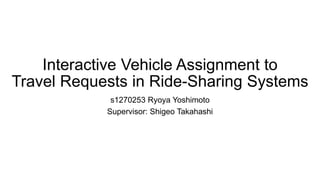
Assignment12 s1270253.pptx
- 1. Interactive Vehicle Assignment to Travel Requests in Ride-Sharing Systems s1270253 Ryoya Yoshimoto Supervisor: Shigeo Takahashi
- 2. Outlines • Motivations • Objectives • Methodology • Result
- 3. Outlines • Motivations • Objectives • Methodology • Result
- 4. Motivations • Growing demand for ride-sharing systems as a cost-effective means of transportation • Designing fundamental ride-sharing plans by solving various scheduling problems call pick up
- 5. Outlines • Motivations • Objectives • Methodology • Result
- 6. Objectives • Implementing a system for interactively assigning passengers and vehicles [1] Which vehicle should pick up a passenger?
- 7. Outlines • Motivations • Objectives • Methodology • Results
- 8. Method for optimization • Let 𝑣 and 𝑟 be a model of vehicle and requests. • Each 𝑡 has a vehicle and the requests that the vehicle handles.
- 9. Method for optimization • Penalty function If 𝑟 𝑗 is not assigned because of lack of vehicles etc., much cost will be given as penalty. 𝑗=1 𝑅 𝑐𝑝𝑒𝑛𝑎𝑙𝑡𝑦 ∙ 𝑥𝑗 where 𝑥𝑗 = 1 if 𝑥𝑗 is not assigned 0 otherwise
- 10. Method for optimization Objective function: min 𝑘=1 𝑇 𝑐𝑘 ∙ 𝑡𝑘 + 𝑗=1 𝑅 𝑐𝑝𝑒𝑛𝑎𝑙𝑡𝑦 ∙ 𝑥𝑗 where 𝑡𝑘 = 1 if 𝑡𝑘 is chosen 0 otherwise where 𝑥𝑗 = 1 if 𝑥𝑗 is not assigned 0 otherwise Constrains: ∀𝑟 𝑗 ∈R, 𝑇𝑅 𝑡𝑘 + 𝑥𝑗 = 1, 𝑇𝑅 = {𝑘| 𝑡𝑘 is include 𝑟 𝑗} ∀𝑣𝑖 ∈V, 𝑇𝑉 𝑡𝑘 ≤ 1, 𝑉𝑉 = {𝑘| 𝑡𝑘 is include 𝑣𝑖}
- 11. Outlines • Motivations • Objectives • Methodology • Result
- 13. References [1] J. Alonso-Mora et al., “On-Demand High-Capacity Ride- Sharing via Dynamic Trip-Vehicle Assignment”, PNAS, 114(3), 462-467, 2017. DOI: 10.1073/pnas.1611675114
Editor's Notes
- 「ライドシェアシステムにおける乗車要求への対話的車両割り当て」
- Ridesharing is a means of transportation in which passengers designate where they want to get in and out of the vehicle, and the vehicle comes to them. ライドシェアとは、乗客が乗り降りする場所を指定し、そこに車両がやってくるという交通機関である Designing fundamental ride-sharing plans leads
- I will explain the method for optimization simply. : A t does not consider all vehicle/request combinations. A t is recorded as a vehicle/request combination only if a vehicle can handle requests under a threshold, or carpooling would not take too much time.
- In addition, we consider a penalty function. If 𝑟 𝑗 is not assigned because of lack of vehicles etc., much cost will be given as penalty.
- Given these factors, the final optimization function looks like this. Constrains represents that each vehicle and requests are chosen once. Considering that a certain request is not chosen, in that case, xj takes 1, so that the sum is 1.